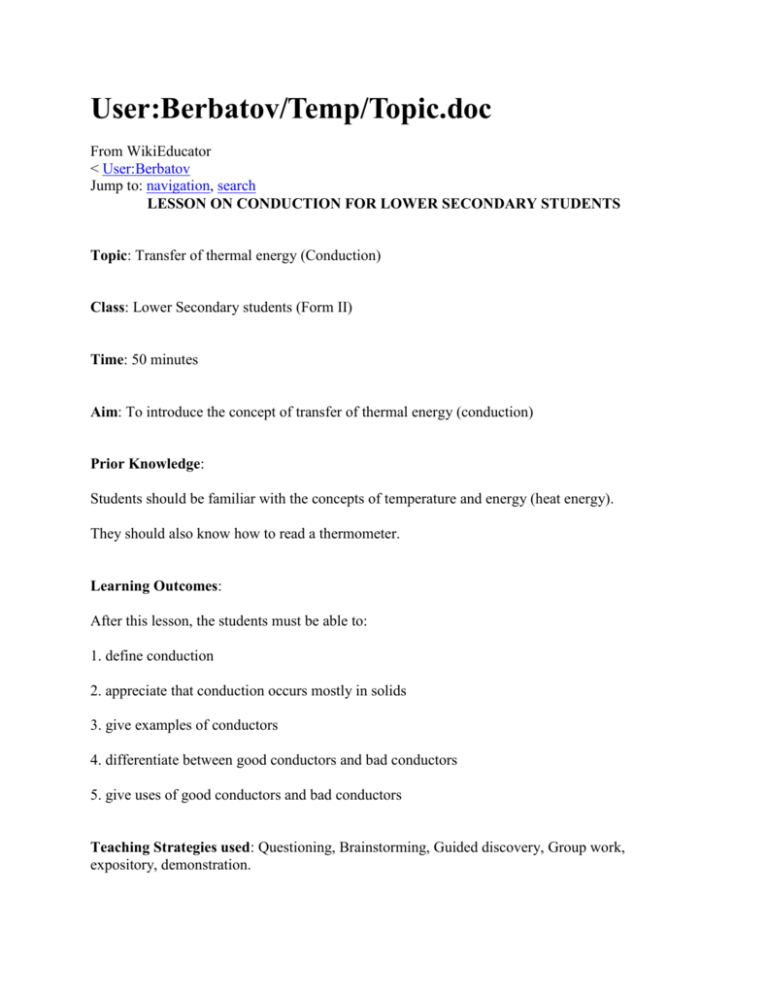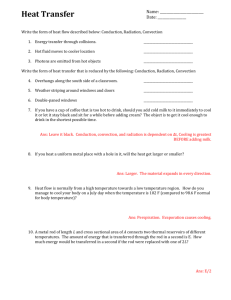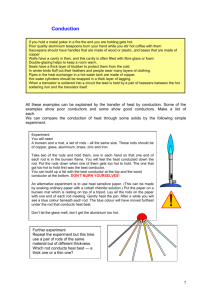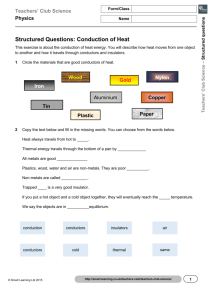Document 9059566
advertisement

User:Berbatov/Temp/Topic.doc From WikiEducator < User:Berbatov Jump to: navigation, search LESSON ON CONDUCTION FOR LOWER SECONDARY STUDENTS Topic: Transfer of thermal energy (Conduction) Class: Lower Secondary students (Form II) Time: 50 minutes Aim: To introduce the concept of transfer of thermal energy (conduction) Prior Knowledge: Students should be familiar with the concepts of temperature and energy (heat energy). They should also know how to read a thermometer. Learning Outcomes: After this lesson, the students must be able to: 1. define conduction 2. appreciate that conduction occurs mostly in solids 3. give examples of conductors 4. differentiate between good conductors and bad conductors 5. give uses of good conductors and bad conductors Teaching Strategies used: Questioning, Brainstorming, Guided discovery, Group work, expository, demonstration. Teaching Aids: Beakers, Water, Bunsen burners, Tripods, Wire Gauze, Thermometer, Metal Rods made of different materials, Wax, Thumb tacks, Stand, Clamp, Blackboard, Chalks. References: MIE Textbook- Science Form II, New Secondary Science Book I, Pan Pacific Publications Methodology: Starts on next page Time and Teaching Strategies used 5 mins. First teacher asks the students for their attention and get ready for the class, Description of activities/Procedure Students will note the objectives in their copybooks. Teacher tells the students about the objectives of the lesson. 1. Ask students to fill their beakers with water. 2. Heat their beakers with a Bunsen flame. 3. What do you notice? Expected ans: The water becomes hot. 10 mins group work/questioning 4. How can you verify it? The students will be provided with beakers and thermometers. Testing Expected ans: By touching the beaker. By using a of prior knowledge, questioning. thermometer. Teacher will move around to ensure that everything is ok. (safety measures) Here teacher explains the use of a mercury thermometer which can be used to measure temperature. 5. Ask the students to verify this by putting the thermometer vertically with the help of retort stands in contact with the water. 6. What happens to the mercury level? Ans: It rises 7. Why is this so? Ans: Because it is in contact with the water and has absorbed the heat from the hot water. Ask the students to note the temperature of the water. Teacher will clearly explain that there is transfer of thermal energy from the Bunsen flame to the water and then when the thermometer is placed in the water, there is transfer of heat from the water to the thermometer. This is why the mercury level will rise. Hence the temperature increases. The purpose of doing this activity is to test prior knowledge that is whether they know about measurement of temperature which they have already learnt in Form I and also to make them more familiar with the use of a thermometer and a Bunsen burner. Also it is a good way to introduce the concept of conduction since the same apparatus will be used in the next activity. Time and Teaching Strategies used 20 mins Guided discovery, questioning, expository Description of activities/Procedure The beakers will be used (A temperature of 90°C will be used in this activity.)Each group will be provided with a metal rod and a glass rod. 1. Ask the students to hold the rods. Teacher will ask if they are hot or cold. Introduction of the concept conduction Ans: Cold 10 mins 2. Now ask them to put the rods into the beaker without letting water splash out and ask them to wait for 1 min. Demonstration showing conduction in a metal rod. (To check understanding) 3. Tell the students to see that one end of the rod is in water and the other end is outside. Will the ends of the rods which are inside the beaker become hot? Ans: Yes 15 mins 4. Will the ends which are outside the water become hot? Guided discovery, questioning Ans: Yes Introducing the concept good conductors. 5. Tell the students to verify their statements by touching the ends which is outside the beaker. 5 mins 6. According to you why is this so? Brainstorming, Group work Expected Ans: Some will say that the water Uses of good conductors and bad conductors of heat has made the metal rod hot. The high fliers will say that since the metal rod is in contact with the water, there is transfer of thermal energy. 10 mins 7. Which end is hotter, the glass one or the one which is made of metal? Recapitulation Ans. The metal rod is hotter. 8. Why do you think this is so? Ans. No ans. 9. What is it inside the metal that makes it become hotter than the glass rod? Ans: No answer At this point, the teacher introduces the concept of free electrons and tells the students that in a metal there are free electrons and that when a metal is heated at one end, the free electrons acquire thermal energy and hence they move towards the other end of the metal. Teacher asks the students to take all these observations under those which they have already taken during the beginning of the lesson. 8. Ask the students if the metal rods have moved from their original positions. Ans: No Then the teacher introduces the concept of conduction. Teacher writes the definition of conduction. It is the transfer of heat from a hot region to a cold region without movement of the material itself. Tell the students that conduction occurs mostly in solids. After each activity, the materials are put away from the students, otherwise they will have the tendency to play with all the materials and also for safety reasons. Teacher will take one metal rod and will clamp it. Wax is applied on to the free end. At different positions, thumb tacks are placed. The set-up is as shown: [[Image:]] By adjusting the stand, the end of the metal rod which does not contain wax is heated with a Bunsen burner. Ask the students to observe what happens and write it in their notebooks. Ans: The wax melts and the thumb tacks fall. Here the students’ observation is very important because they will notice that the thumb tacks will fall in a certain order. From the diagram, it will be from the left to the right. A demonstration will be shown to the students. The experiment will consist of heating 6 rods made of 6 different materials. The materials are iron, aluminium, copper, wood, glass, plastic. The rods will be coated with wax and a thumb tack fitted to each off them. (a lab attendant will help) 1. Are all solids good conductors of heat? Ans: Yes. Wrong answer 2. The rods are heated with the help of Bunsen burners. It is made sure that the rods are heated at the same temperature. The students are told to observe what happens and to note their observations. 3. What do you observe? Ans: The thumb tacks fall off the rods. 4. Have you observed the order in which the thumb tacks fall? Ans: Yes Here most of the students will have noticed that the thumb tacks fall off the aluminium, copper and iron rods first and then a longer time is taken for the thumb tacks to fall off the glass, wood and plastic rods. The rods are then placed in the order in which the thumb tacks have fallen. Then the students will record the order in their copybooks. At this point, the teacher will introduce the concept of good conductors and bad conductors. The rods from which the thumb tacks have fallen first are good conductors of heat. 5. With what materials have the rods been made? Ans: iron, aluminium, copper 6. What are they? Ans: Most will say metals. At this point teacher tells the students that metals are good conductors of heat. 7. What about the rest? Ans: They are bad conductors Teacher will tell the students that a special name is given to bad conductors and the name is thermal insulators. Teacher will ask students to draw two columns and the headings will be good conductors and bad conductors (insulators). Then the students will write down examples of good and bad conductors. One student will come on the blackboard to write the names and then after verification, the students will correct their list in their respective copybooks. Students are now familiar with good conductors and bad conductors. Now they will work in groups to discuss some uses of good conductors and bad conductors which they will write in their copybooks. One example of a use of a good conductor will be frying pans which are copperbased. Similarly one example of a use of a bad conductor will be that of wood which is used to make handles of domestic equipment ( e.g casserole) A summary of the different concepts is done together with some short notes. Follow up: 1. Worksheets containing small exercises on conduction will be given to students. The small exercises will consist of multiple choice questions, short structured questions and also fill in the blank type questions. 2. The use of audio-visual equipments where the students will be able to see some demonstrations of conduction. 3. Use of the internet and animations to show to students some simulations on temperature change, transfer of energy. 4. Ask students if they have encountered real life situations about conduction. A good example will be the cooking of food at home. Students will be asked to describe what are the processes involved and the related concepts. 5. Students will also be asked to do a small project on what they have learnt about conduction and also to do some additional research. Retrieved from "http://wikieducator.org/index.php?title=User:Berbatov/Temp/Topic.doc&oldid=644910" Navigation menu Personal tools Log in Request account Namespaces User page Discussion Variants Views Read View source View history Actions Search Search Go Navigation Main Page Recent changes Help Practice editing Community Community portal Web chat Mailing list Print/export Create a book Download as PDF Printable version Tools What links here Related changes User contributions Logs Upload file Special pages Permanent link Page information This page was last modified on 22 December 2010, at 11:59. This page has been accessed 197 times. Content is available under the Creative Commons Attribution Share Alike License unless otherwise noted. Privacy policy About WikiEducator Disclaimers









